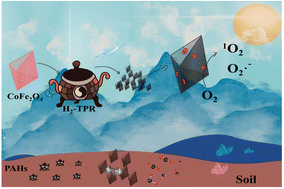The rational design of photocatalytic nanomaterials with unique structures is critical for remediating environmental problems and thus reducing ecological risks. In this work, we employed H2 temperature-programmed reduction to modify MFe2O4 (M = Co, Cu, and Zn) photocatalysts for obtaining additional oxygen vacancies. After activation of PMS, naphthalene and phenanthrene degradation rates in the soil phase were increased by 3.24-fold and 1.39-fold, respectively, and 1.38-fold for naphthalene in the aqueous phase by H-CoFe2O4−x. The extraordinary photocatalytic activity is attributed to the oxygen vacancies on the H-CoFe2O4−x surface, which promote electron transfer and thus enhance the redox cycle from Co(III)/Fe(III) to Co(II)/Fe(II). In addition, oxygen vacancies are used as electron traps to hinder the recombination of photogenerated carriers and accelerate the generation of hydroxyl and superoxide radicals. Quenching tests showed that the addition of p-benzoquinone resulted in the greatest decrease in the degradation rate of naphthalene (inhibition of about 85.5%), demonstrating that O2˙− radicals are the main active species in the photocatalytic degradation of naphthalene. H-CoFe2O4−x showed improved degradation performance in synergy with PMS (82.0%, kapp = 0.00714 min−1) while maintaining excellent stability and reusability. Hence, this work provides a promising approach for the design of efficient photocatalysts to degrade persistent organic pollutants in soil and aqueous environments.
